The British Monarchy Monarchy of the United Kingdom

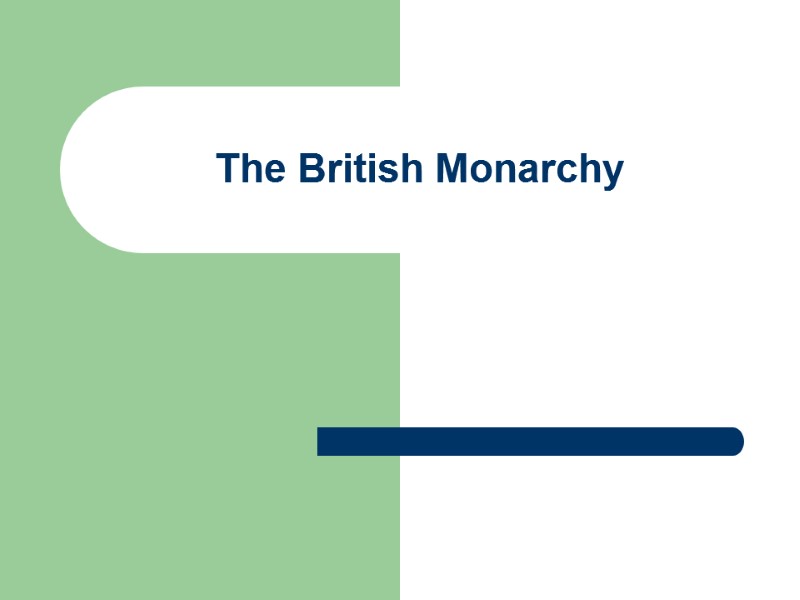
The British Monarchy
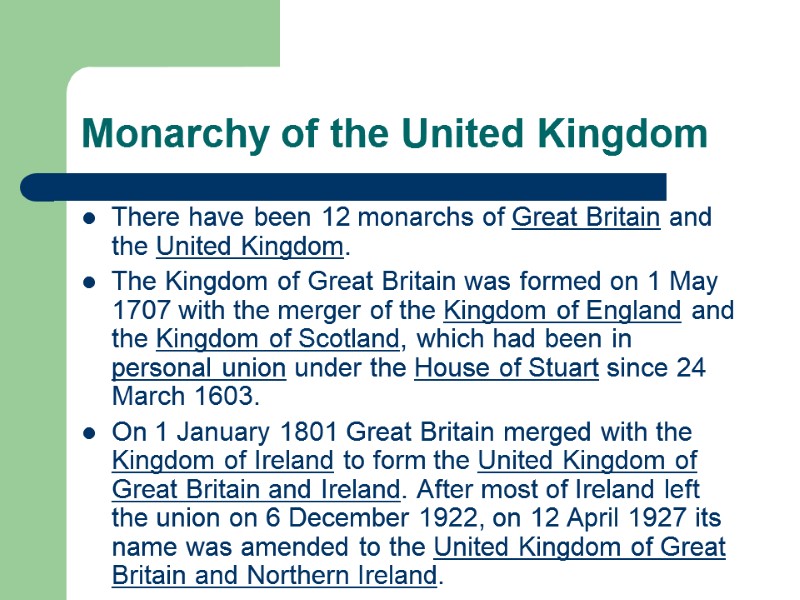
Monarchy of the United Kingdom There have been 12 monarchs of Great Britain and the United Kingdom. The Kingdom of Great Britain was formed on 1 May 1707 with the merger of the Kingdom of England and the Kingdom of Scotland, which had been in personal union under the House of Stuart since 24 March 1603. On 1 January 1801 Great Britain merged with the Kingdom of Ireland to form the United Kingdom of Great Britain and Ireland. After most of Ireland left the union on 6 December 1922, on 12 April 1927 its name was amended to the United Kingdom of Great Britain and Northern Ireland.
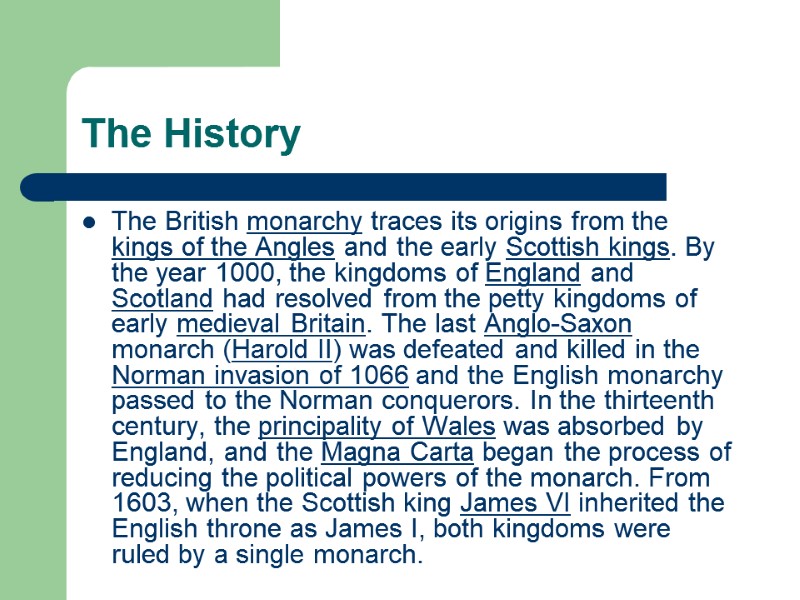
The History The British monarchy traces its origins from the kings of the Angles and the early Scottish kings. By the year 1000, the kingdoms of England and Scotland had resolved from the petty kingdoms of early medieval Britain. The last Anglo-Saxon monarch (Harold II) was defeated and killed in the Norman invasion of 1066 and the English monarchy passed to the Norman conquerors. In the thirteenth century, the principality of Wales was absorbed by England, and the Magna Carta began the process of reducing the political powers of the monarch. From 1603, when the Scottish king James VI inherited the English throne as James I, both kingdoms were ruled by a single monarch.
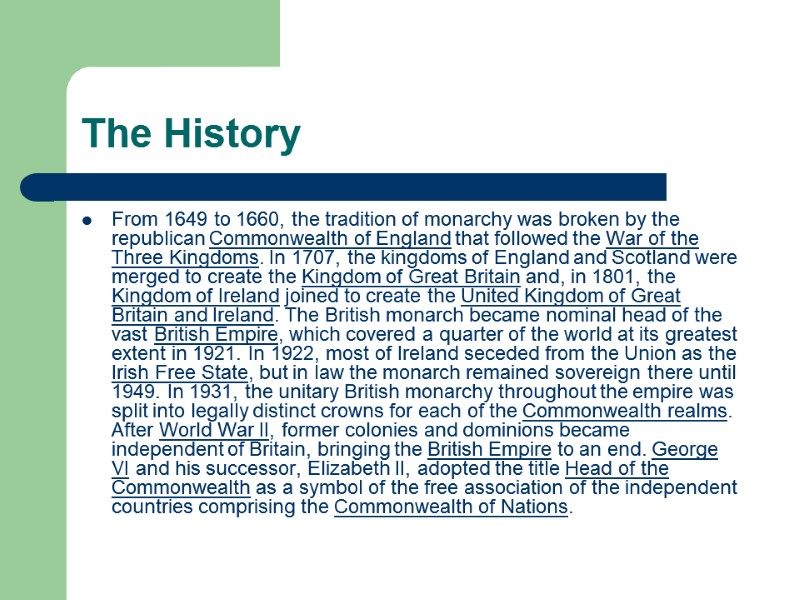
The History From 1649 to 1660, the tradition of monarchy was broken by the republican Commonwealth of England that followed the War of the Three Kingdoms. In 1707, the kingdoms of England and Scotland were merged to create the Kingdom of Great Britain and, in 1801, the Kingdom of Ireland joined to create the United Kingdom of Great Britain and Ireland. The British monarch became nominal head of the vast British Empire, which covered a quarter of the world at its greatest extent in 1921. In 1922, most of Ireland seceded from the Union as the Irish Free State, but in law the monarch remained sovereign there until 1949. In 1931, the unitary British monarchy throughout the empire was split into legally distinct crowns for each of the Commonwealth realms. After World War II, former colonies and dominions became independent of Britain, bringing the British Empire to an end. George VI and his successor, Elizabeth II, adopted the title Head of the Commonwealth as a symbol of the free association of the independent countries comprising the Commonwealth of Nations.
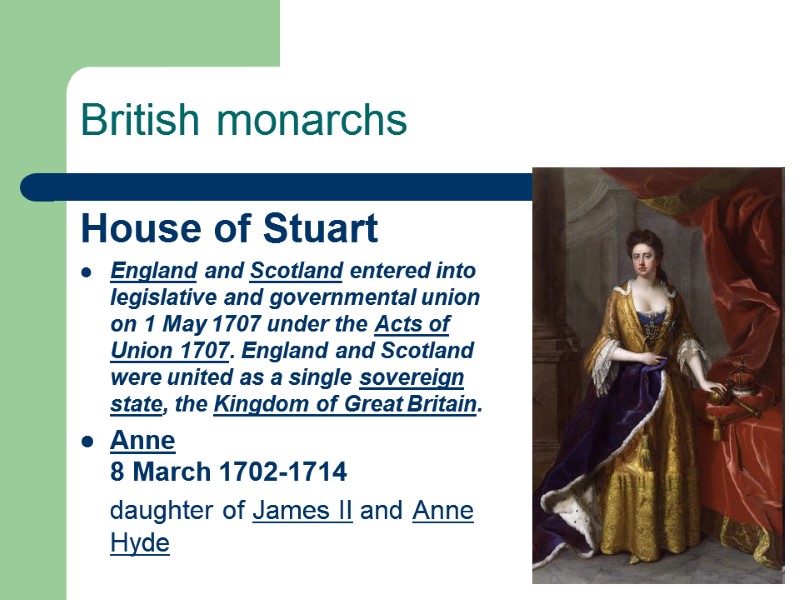
British monarchs House of Stuart England and Scotland entered into legislative and governmental union on 1 May 1707 under the Acts of Union 1707. England and Scotland were united as a single sovereign state, the Kingdom of Great Britain. Anne 8 March 1702-1714 daughter of James II and Anne Hyde
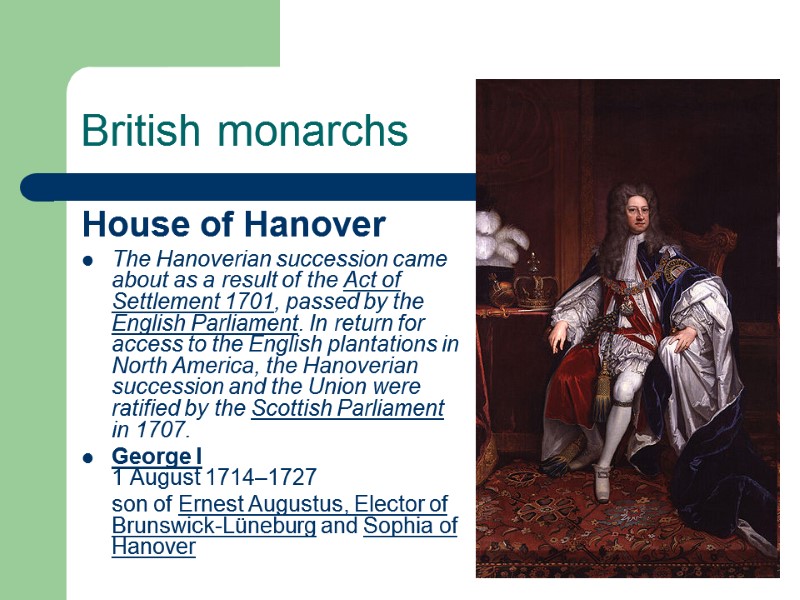
British monarchs House of Hanover The Hanoverian succession came about as a result of the Act of Settlement 1701, passed by the English Parliament. In return for access to the English plantations in North America, the Hanoverian succession and the Union were ratified by the Scottish Parliament in 1707. George I 1 August 1714–1727 son of Ernest Augustus, Elector of Brunswick-Lüneburg and Sophia of Hanover
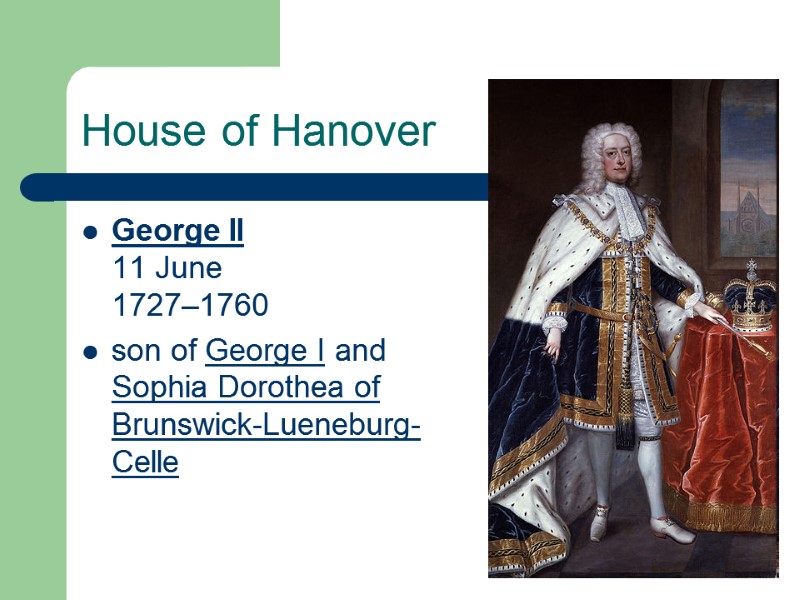
House of Hanover George II 11 June 1727–1760 son of George I and Sophia Dorothea of Brunswick-Lueneburg-Celle
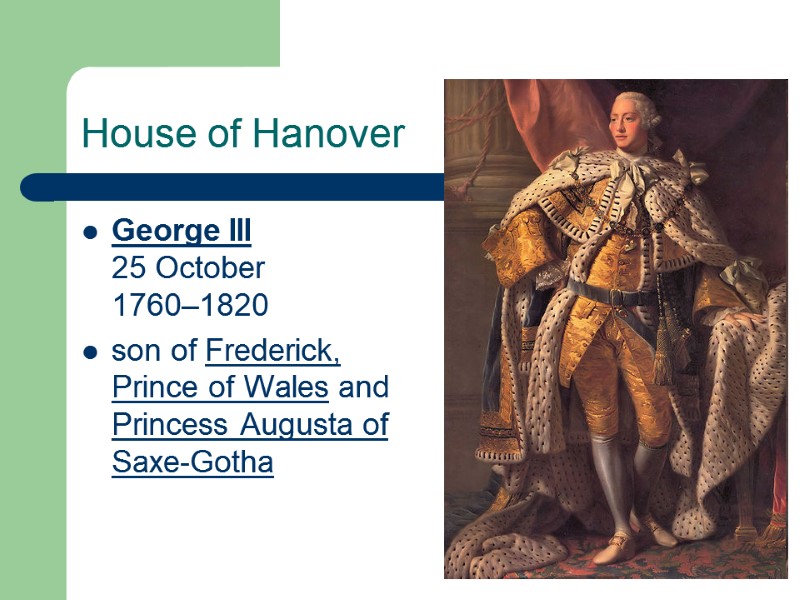
House of Hanover George III 25 October 1760–1820 son of Frederick, Prince of Wales and Princess Augusta of Saxe-Gotha
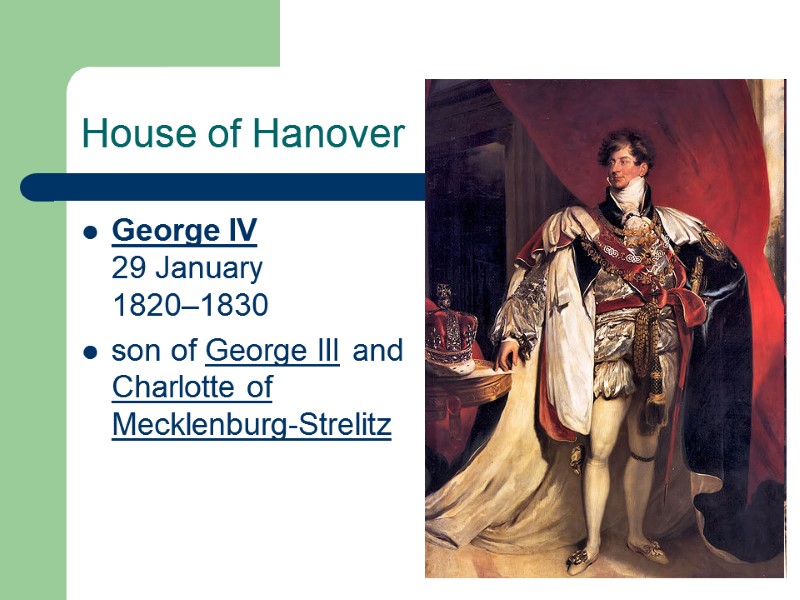
House of Hanover George IV 29 January 1820–1830 son of George III and Charlotte of Mecklenburg-Strelitz
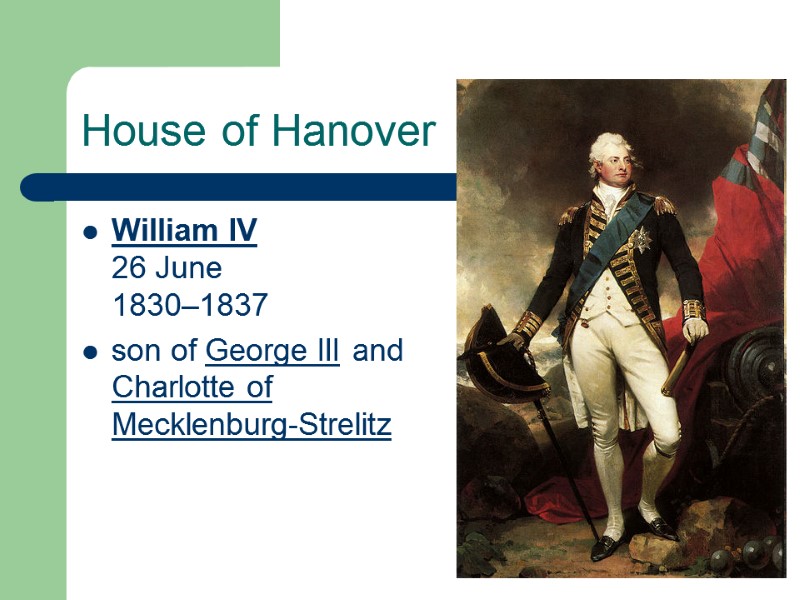
House of Hanover William IV 26 June 1830–1837 son of George III and Charlotte of Mecklenburg-Strelitz
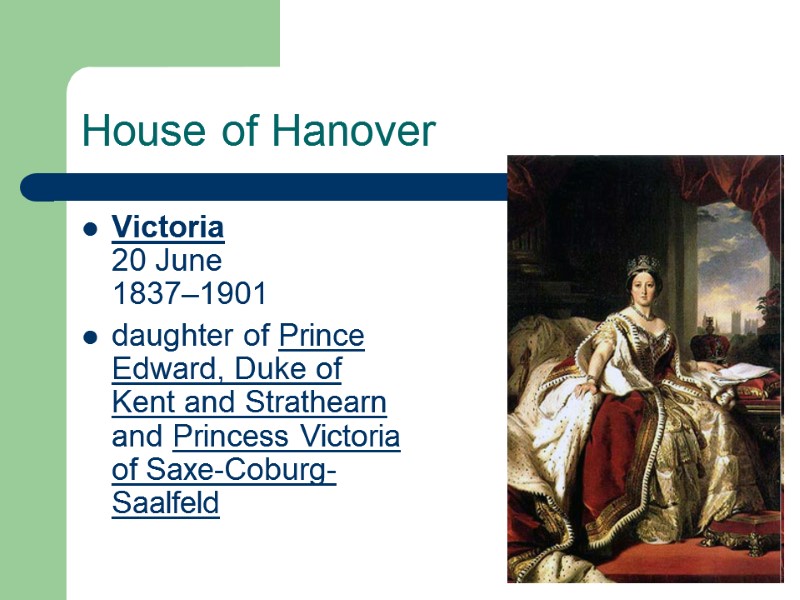
House of Hanover Victoria 20 June 1837–1901 daughter of Prince Edward, Duke of Kent and Strathearn and Princess Victoria of Saxe-Coburg-Saalfeld
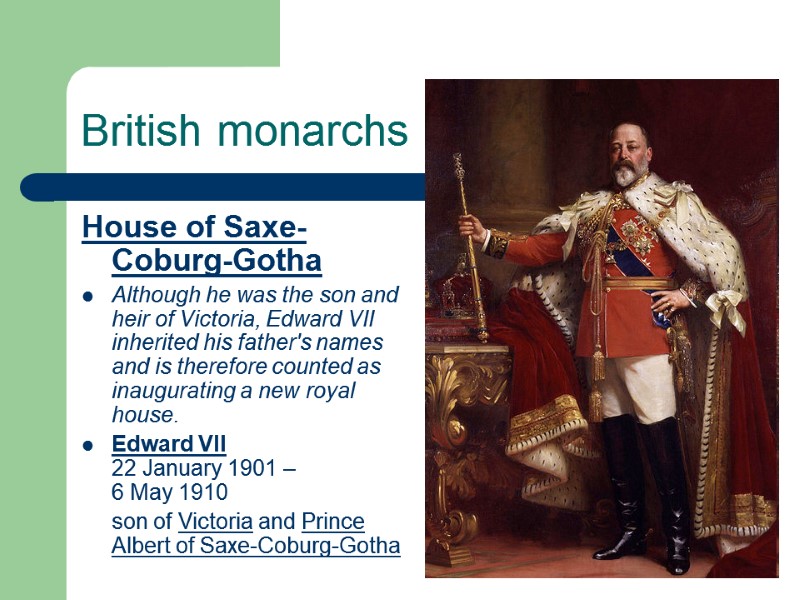
British monarchs House of Saxe-Coburg-Gotha Although he was the son and heir of Victoria, Edward VII inherited his father's names and is therefore counted as inaugurating a new royal house. Edward VII 22 January 1901 – 6 May 1910 son of Victoria and Prince Albert of Saxe-Coburg-Gotha

British monarchs House of Windsor The house name Windsor was adopted in 1917, during the First World War. It was changed from Saxe-Coburg-Gotha because of wartime anti-German sentiment. George V 6 May 1910 – 20 January 1936 son of Edward VII and Alexandra of Denmark
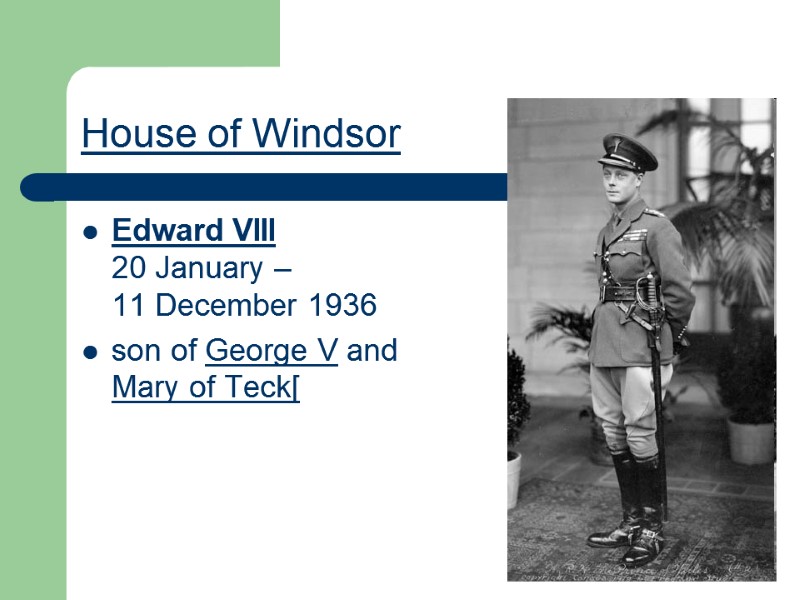
House of Windsor Edward VIII 20 January – 11 December 1936 son of George V and Mary of Teck[
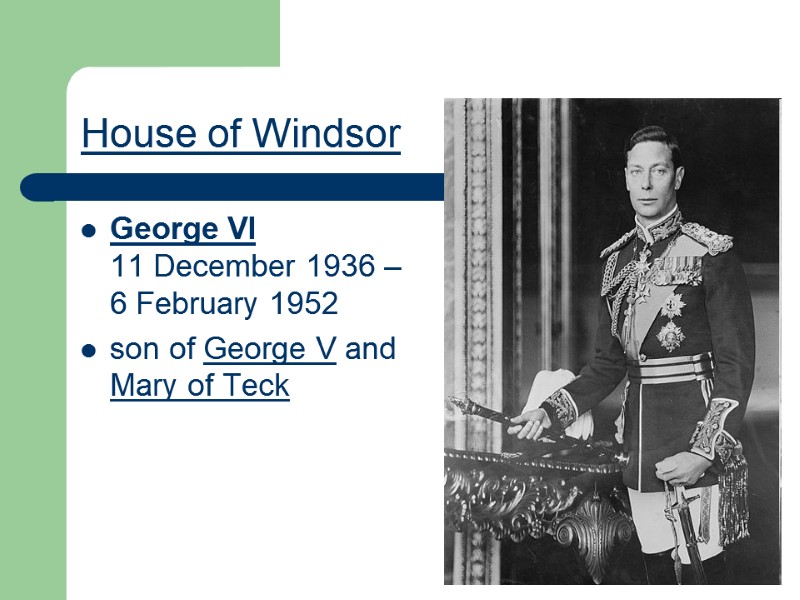
House of Windsor George VI 11 December 1936 – 6 February 1952 son of George V and Mary of Teck
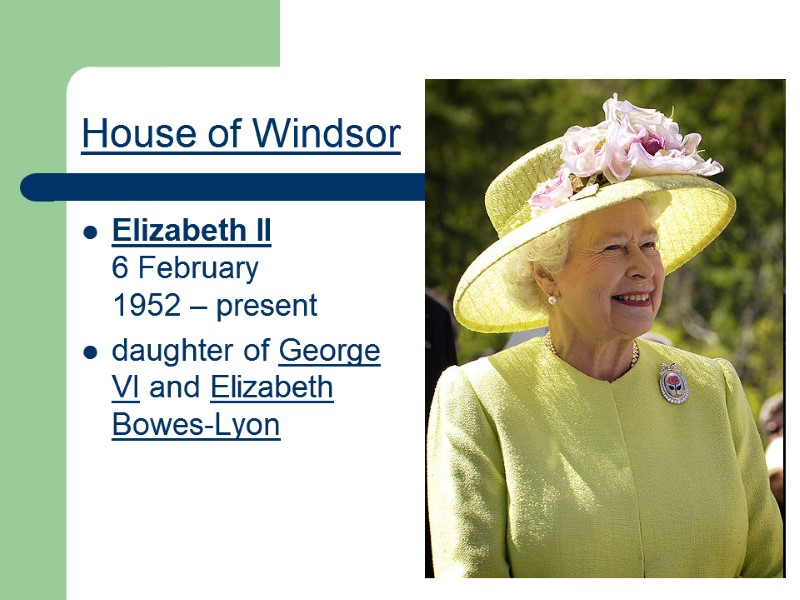
House of Windsor Elizabeth II 6 February 1952 – present daughter of George VI and Elizabeth Bowes-Lyon
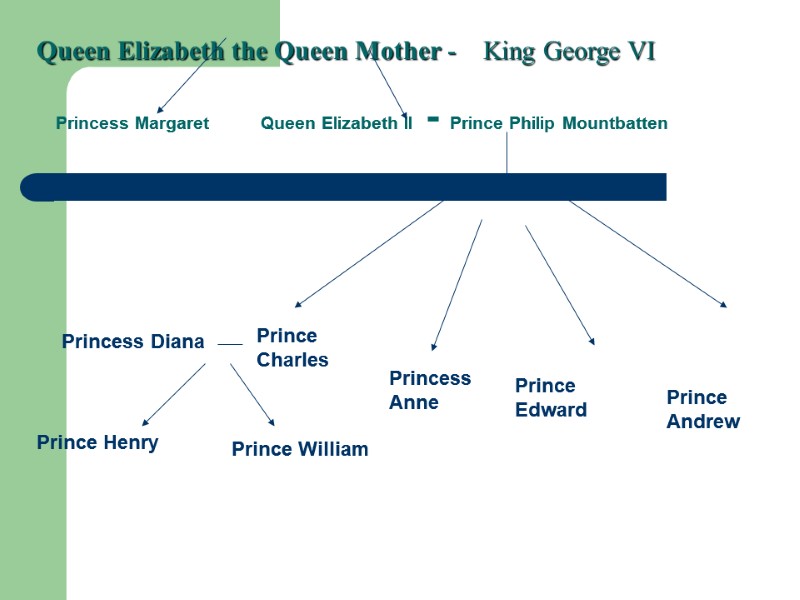
Princess Margaret Queen Elizabeth II - Prince Philip Mountbatten Queen Elizabeth the Queen Mother - King George VI Prince Charles Princess Anne Prince Edward Prince Andrew Princess Diana Prince Henry Prince William
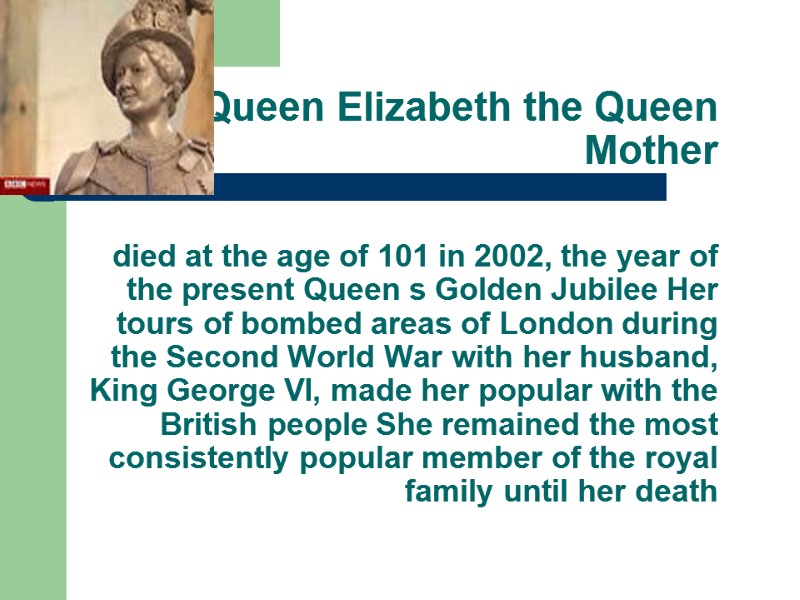
Queen Elizabeth the Queen Mother died at the age of 101 in 2002, the year of the present Queen s Golden Jubilee Her tours of bombed areas of London during the Second World War with her husband, King George VI, made her popular with the British people She remained the most consistently popular member of the royal family until her death
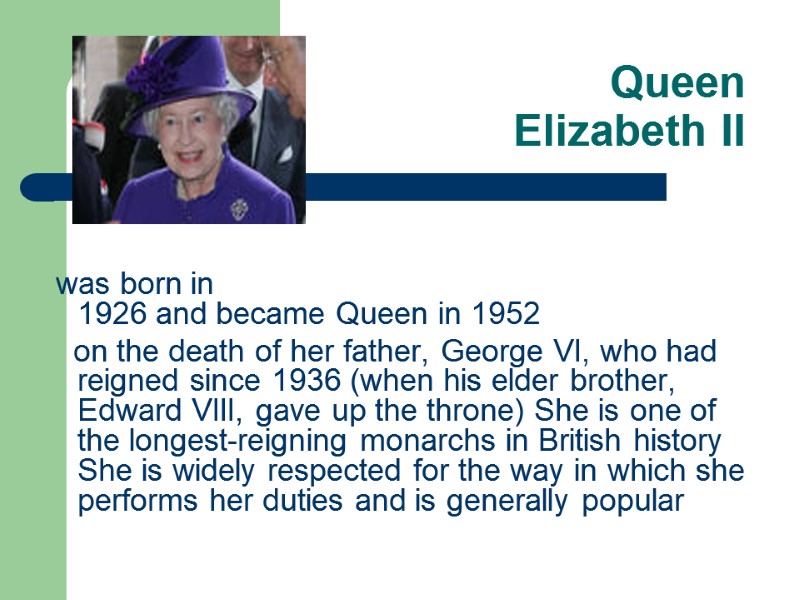
Queen Elizabeth II was born in 1926 and became Queen in 1952 on the death of her father, George VI, who had reigned since 1936 (when his elder brother, Edward VIII, gave up the throne) She is one of the longest-reigning monarchs in British history She is widely respected for the way in which she performs her duties and is generally popular
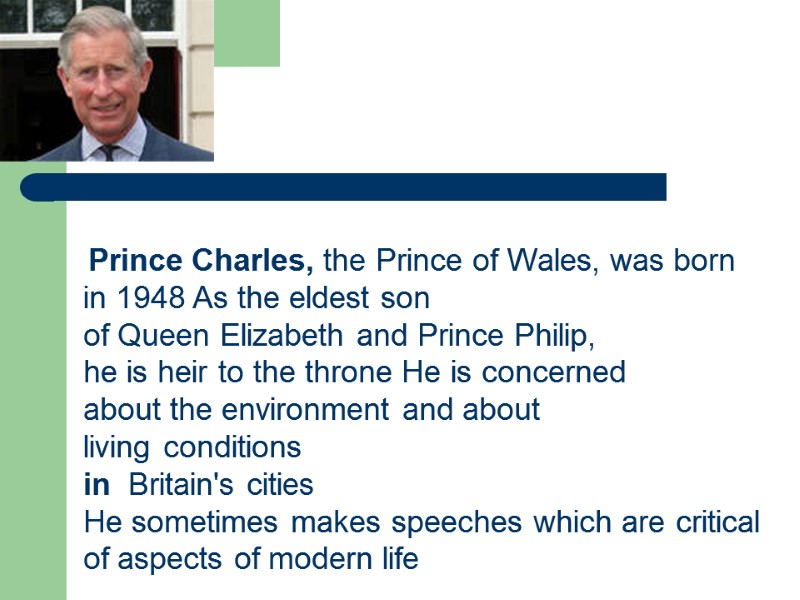
Prince Charles, the Prince of Wales, was born in 1948 As the eldest son of Queen Elizabeth and Prince Philip, he is heir to the throne He is concerned about the environment and about living conditions in Britain's cities He sometimes makes speeches which are critical of aspects of modern life
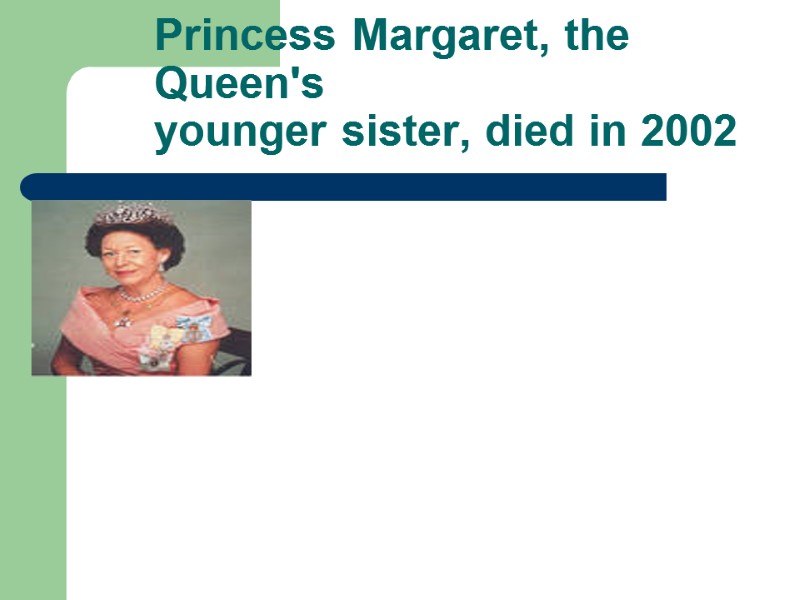
Princess Margaret, the Queen's younger sister, died in 2002
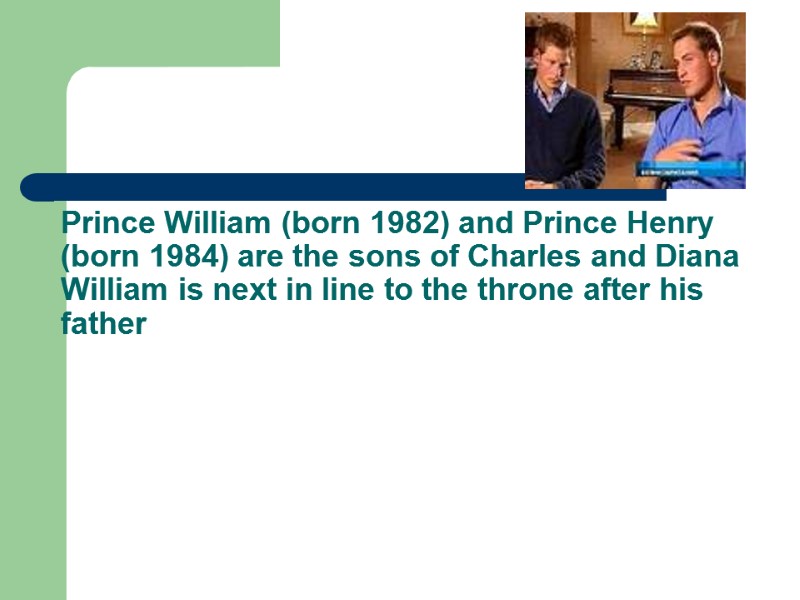
Prince William (born 1982) and Prince Henry (born 1984) are the sons of Charles and Diana William is next in line to the throne after his father
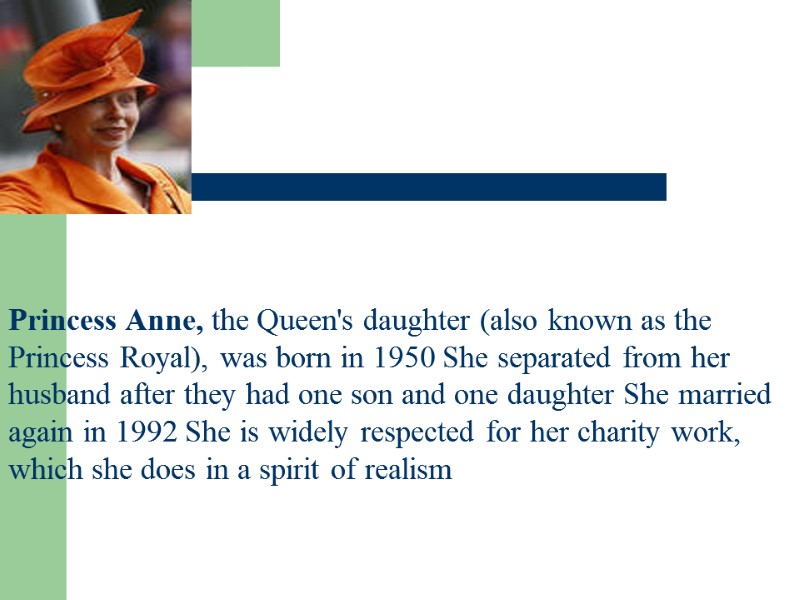
Princess Anne, the Queen's daughter (also known as the Princess Royal), was born in 1950 She separated from her husband after they had one son and one daughter She married again in 1992 She is widely respected for her charity work, which she does in a spirit of realism
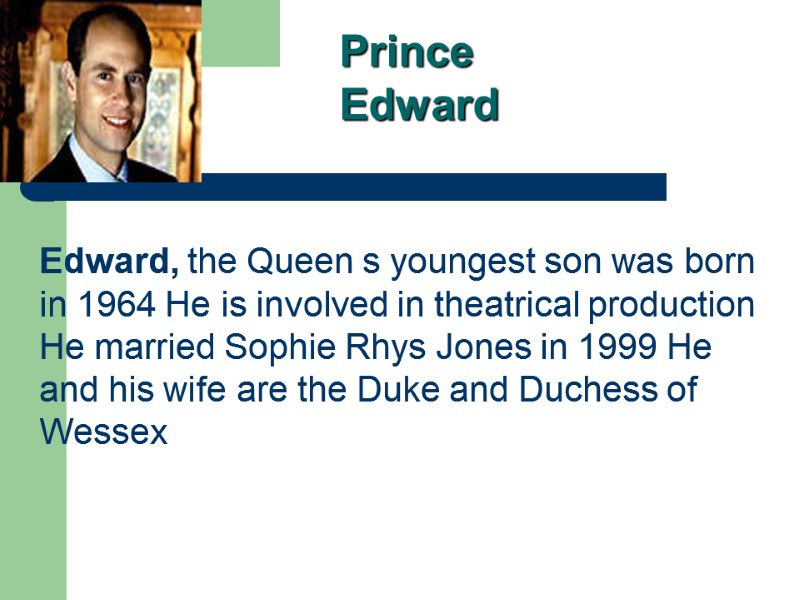
Prince Edward Edward, the Queen s youngest son was born in 1964 He is involved in theatrical production He married Sophie Rhys Jones in 1999 He and his wife are the Duke and Duchess of Wessex
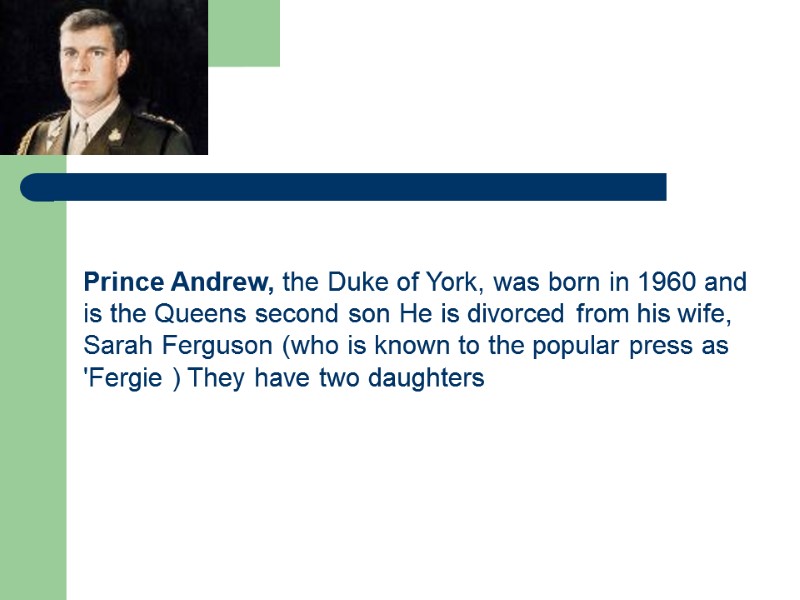
Prince Andrew, the Duke of York, was born in 1960 and is the Queens second son He is divorced from his wife, Sarah Ferguson (who is known to the popular press as 'Fergie ) They have two daughters
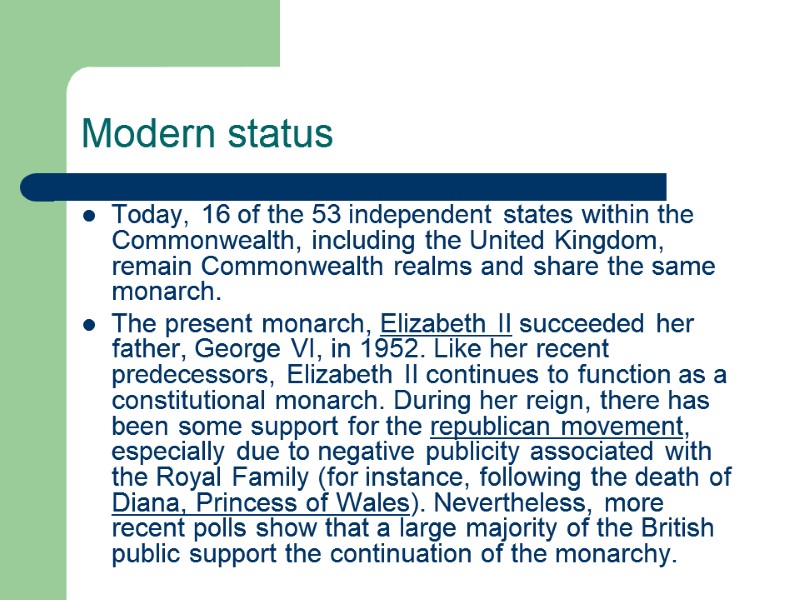
Modern status Today, 16 of the 53 independent states within the Commonwealth, including the United Kingdom, remain Commonwealth realms and share the same monarch. The present monarch, Elizabeth II succeeded her father, George VI, in 1952. Like her recent predecessors, Elizabeth II continues to function as a constitutional monarch. During her reign, there has been some support for the republican movement, especially due to negative publicity associated with the Royal Family (for instance, following the death of Diana, Princess of Wales). Nevertheless, more recent polls show that a large majority of the British public support the continuation of the monarchy.
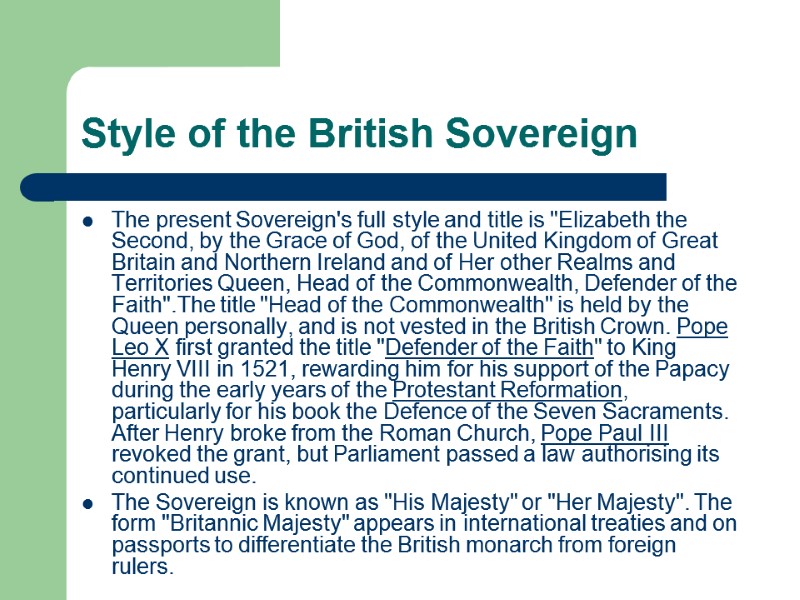
Style of the British Sovereign The present Sovereign's full style and title is "Elizabeth the Second, by the Grace of God, of the United Kingdom of Great Britain and Northern Ireland and of Her other Realms and Territories Queen, Head of the Commonwealth, Defender of the Faith".The title "Head of the Commonwealth" is held by the Queen personally, and is not vested in the British Crown. Pope Leo X first granted the title "Defender of the Faith" to King Henry VIII in 1521, rewarding him for his support of the Papacy during the early years of the Protestant Reformation, particularly for his book the Defence of the Seven Sacraments. After Henry broke from the Roman Church, Pope Paul III revoked the grant, but Parliament passed a law authorising its continued use. The Sovereign is known as "His Majesty" or "Her Majesty". The form "Britannic Majesty" appears in international treaties and on passports to differentiate the British monarch from foreign rulers.
11392-the_british-monarchy.ppt
- Количество слайдов: 27

